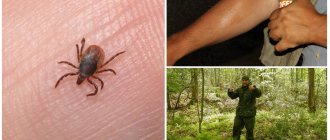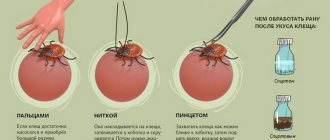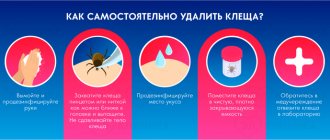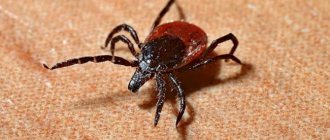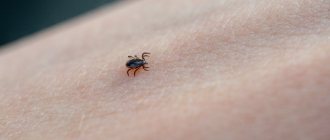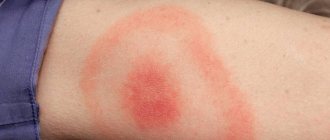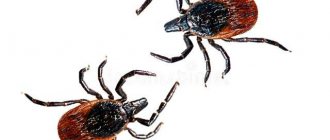Where to submit a tick that has bitten a person. Where laboratory research is carried out in Moscow. Cost of laboratory tests. Over what period can results be obtained? Where can you donate blood for testing after a tick bite? Cost of analysis.
We all know how important it is to protect yourself from ticks in nature. You need to choose the right clothes, avoid thickets where they are most concentrated, and use specialized products, the choice of which is very large today. Since these parasites are carriers of dangerous diseases, we must protect ourselves as much as possible. The fact is that these diseases do not have pronounced symptoms and an infected person may not even realize that he is infected for a long time.
Only when the disease becomes severe is the disease most often diagnosed, but unfortunately treatment at this stage is no longer effective. In order to avoid difficult situations, you need to know whether the insect that bit you has an infection. Next, information will be provided on where to submit a tick for analysis in Moscow, as well as where to go if bitten.
What to do if a tick is found on your body?
The very first and most important rule when you are bitten by a parasite is to trust the professionals; you can go to an ambulance, where services are provided around the clock. The fact is that in order to be able to carry out subsequent tests to determine whether an insect has an infection, it is necessary to preserve the integrity of the tick and transport it alive. To do this, you need to carry out the procedure carefully. In addition, time plays an important role; the longer the parasite is in contact with a person, namely with his blood, the more the likelihood of infection increases.
Health workers do not recommend carrying out the procedure yourself, and there are reasons for this. Quite often, the attached tick is not completely removed, its particles remain under the skin, then this causes inflammation, if no measures are taken, the wound may fester and complications may occur.
Once a tick has bitten, it must be removed within 24 hours. Considering that insect attacks occur in nature, outside the city, it is not always possible to consult a doctor in time.
You can carry out all the manipulations yourself, but to do this you must follow the following recommendations:
- The procedure should be carried out only with rubber gloves. You should not touch an insect without protective equipment.
- In order to remove the parasite, you can use a thread or tweezers.
- Methods such as dousing with oil should not be used. The fact is that this can cause the death of the parasite, and this increases the likelihood that during death it will secrete saliva, which will cause infection.
- Using a thread or tweezers, you need to grab the tick as close to the head as possible.
- You cannot squeeze the body too much, pull it out, or make sudden movements.
- You must try to pull it out. The parasite is reached only with upward movements, perpendicular to the body.
- You cannot twist the body, shake it from side to side, or pull it at an angle.
- After the insect is removed, it must be placed in any glass container that can be closed. You also need to put some piece of fabric in this container, but it must be damp. This is necessary in order to preserve the vital activity of the parasite.
- Next, be sure to disinfect the bite site, as well as your hands.
- After the insect is removed, it must be tested within 24 hours.
How to preserve a tick for analysis
If a parasite is found attached to the body, actions to remove it must be carried out very quickly, since the likelihood of infection increases as the duration of the insect’s contact with blood increases. In addition to speed, the caution of the manipulations performed is of great importance to ensure the integrity of the arachnid for the purpose of its subsequent transfer for analysis (the individual should be checked for tick-borne infections).
- Free medical examination in 2022
- Registration of disability for pensioners - grounds for obtaining and necessary documents
- 4 Prostate Problems You Shouldn't Ignore
It is not recommended to remove a tick yourself; this should be done by qualified medical professionals. It is necessary to get rid of the insect within 24 hours from the moment of suction, but it is not always possible to quickly seek qualified help. In this case, it is allowed to extract the parasite on your own or with the help of third-party assistants. To minimize the risk of infection and preserve the specimen for laboratory tests, you must adhere to the following rules:
- All manipulations should be performed with gloves (the arthropod should not be allowed to come into contact with exposed areas of the hands).
- You can use available means (thick thread, tweezers) to pull out the insect, but attempts to pour oil on it can lead to the death of the insect with the injection of its saliva, which will increase the likelihood of infection.
- The attached parasite should be pulled out from the skin perpendicular to the surface of the body, holding it as close to the head as possible without squeezing the body.
- Pulling movements should be directed strictly upward (in relation to the surface of the body), without twisting or loosening the parasite.
- Place the insect inside a clean glass container (to maintain the viability of the individual, you must place a damp piece of cloth in the container).
- Disinfect your hands and the bite site.
- Within 24 hours after the tick detaches, it must be taken to the laboratory for analysis.
Where are tests performed?
In order to be able to check and obtain the most accurate tests, the insect must be taken whole and alive. But there are institutions that accept dead individuals for analysis and even give away individual parts of it, but it should be borne in mind that such results will not be as accurate as possible.
You can take it for testing to the following institutions:
- Federal State Institution "Center for Hygiene and Epidemiology in Moscow", at the address: Grafsky lane, 4. Telephone.
- Center for Sanitary and Epidemiological Expertise and Certification, at the address: st. Pyatnitskaya, 45. Telephone.
- FBUZ "Center for Hygiene and Epidemiology for Railway Transport", at the address: St. Khodynskaya, 10a. Phone: (499) 253-01-31.
- Hygienic education center for the population, at the address: 1st Smolensky lane, 9. Telephone.
- Federal Center for Hygiene and Epidemiology, Varshavskoe Shosse, 19a.
- Head Center of Hygiene and Epidemiology, 1st Pekhotny Lane, 6, (499) 190-48-61.
Center for Hygiene and Epidemiology (check by district):
- Central Administrative District, Krasnogvardeisky Boulevard, 17.
- Zelenogradsky, Kashtanovaya Alley, 6, (495) 9445996.
- South-East, Volgogradsky prospect, 113, (495) 9193632.
References
1. Tick-borne viral encephalitis in adults. Clinical guidelines of the National Scientific Society of Infectious Diseases, 2014 2. https://www.rospotrebnadzor.ru/about/info/predpr/news_predpr.php?ELEMENT_ID=14010&sphrase_id... 3. Lyme disease in adults. Clinical recommendations of the Ministry of Health of the Russian Federation, 2016 4. Klimova Yu.A. et al. Human granulocytic anaplasmosis // Bulletin of the Peoples' Friendship University of Russia. Series: Medicine, 2022 5. Zlobin V.I. Tick-borne vector-borne infections // V.I. Zlobin, N.V. Rudakov, I.V. Malov. – Novosibirsk: Nauka, 2015. – 224 p.
Required documents
All expenses required to conduct the necessary research are borne by the person who contacts the institution. It is advisable, before taking it to the institution, to call them back and clarify the possibility of taking it for research. When a person wishes to conduct these tests, it is necessary to provide laboratory personnel with information regarding the location where the bite occurred and the time at which it occurred.
Next you need to provide documents:
- Passport.
- Medical insurance policy.
- Insurance contract.
In this case, the presence of the last item will ensure full payment for the research.
Duration of the study
The results of the tick analysis are issued after the period stipulated for conducting research in a specific laboratory (set based on technical capabilities). The average duration of microbiological diagnostics is:
| Type of analysis | Duration |
| For borreliosis | Up to 72 hours |
| For encephalitis | Up to 48 hours |
| For other infections | Up to 72 hours |
Price in Moscow and the region
If you submit an insect and have insurance, the procedure is free of charge. But in this case, you need to go to those institutions that are specified in the contract. Otherwise, the procedure is paid, the price may vary depending on the location, the average cost is:
- Encephalitis from 250 to 430 rubles;
- Lyme disease from 593 to 890 rubles;
- Ehrlichiosis from 500 to 800 rubles;
- Anaplasmosis from 500 to 800 rubles;
- Comprehensive research from 2000 to 3000 rubles.
Indications for the purpose of the study
The indication for performing the study is the attachment of a tick to the human body.
Ixodidae) are of greatest epidemiological importance
).
Infections transmitted by ixodid ticks are characterized by spring-autumn seasonality from April to October, however, in regions with warm climates, year-round activity of ixodid ticks is observed. Risk groups for the incidence of infections transmitted by ixodid ticks are residents of urban and rural areas who visit tick habitats. Transmission of infectious agents occurs when infected ticks attach themselves to the human body.
Infections transmitted by ixodid ticks include tick-borne viral encephalitis, ixodid tick-borne borreliosis, tick-borne human granulocytic anaplasmosis, human monocytic ehrlichiosis and others (Q fever, Crimean hemorrhagic fever, tularemia, rickettsiosis).
The causative agent of tick-borne encephalitis
— RNA-containing virus of the genus
Flavivirus
. The incubation period of the disease is, as a rule, 7–14 days from the moment of tick bite, but can last up to 25 days. The infection affects the cells of the brain and spinal cord with the subsequent development of paresis and paralysis.
Identification of the causative agent of tick-borne viral encephalitis in a tick allows for timely emergency prevention of infection. If a positive result is obtained, emergency administration of a specific immunoglobulin is indicated - no later than 72 hours from the moment of the bite. The maximum effectiveness of the drug is observed when it is administered during the first day after the bite.
The causative agent of Lyme disease
- spiral-shaped bacterium of the genus
Borrelia
. The disease develops in 20% of cases after sucking on a tick infected with Borrelia. In 50-80% of patients, local skin inflammation is observed - tick-borne migratory erythema (redness), the diameter of which does not exceed 5 cm. When spreading through the blood, Borrelia affects internal organs, cells of the nervous system, as a result of which meningitis, meningoencephalitis, radiculoneuritis, neuritis can develop cranial nerves.
The causative agent of human granulocytic anaplasmosis
- the bacterium
Anaplasma phagocytophilum
, which infects granulocytes - white blood cells containing granules (neutrophils, eosinophils, basophils). Infection occurs through the bite of a tick infected with bacteria called anaplasma.
Symptoms of the disease include prolonged fever, weakness, headache, sweating, cough, nausea, vomiting, diarrhea, muscle and joint pain. The lymph nodes become enlarged, and damage to the kidneys, liver, and spleen may occur. Inflammation of the membranes of the brain and spinal cord is less commonly diagnosed. The incubation period averages 14 days.
The causative agents of monocytic ehrlichiosis
are bacteria belonging to the genus
Ehrlichia
. They enter the human body with tick saliva, enter the blood through the lymphatic tract and begin to multiply in the cells of the inner surface of blood vessels, in white blood cells - monocytes. After the cell is destroyed, microorganisms leave it and infect others. Internal organs (liver, central nervous system, bone marrow, skin) are affected with the development of infectious granulomas. The clinical picture of ehrlichiosis is similar to granulocytic anaplasmosis.
Human granulocytic anaplasmosis, monocytic ehrlichiosis and borreliosis are indications for antibiotic therapy. With timely detection of the disease and treatment, the prognosis is favorable.
Seasonal activity
The most dangerous time is spring and summer. In mid-August, the risk of infection decreases rapidly. In autumn it almost completely disappears. The daily peak of parasite activity is morning and evening. They are usually found in shaded areas with high humidity. They practically never exist in bright sunny areas. Large concentrations of ticks are observed near paths where animals often pass. Parasites also love pastures. In the middle of the day, in extreme heat, they usually do not attack. Bloodsuckers also hide in the rain.
It must be remembered that ticks usually crawl from below. There is a well-established belief that they attack their prey from trees, but this is not the case. Usually these insects live in the lower tier, where the height of the grass does not exceed 1 m. In such places they are much better protected from sunlight.
There is never any pain felt during a tick bite. After about 24 hours, a pulling sensation appears, as well as an inflammatory process in the affected area. The wound in such cases usually heals rather slowly. If a bite is noticed, you need to remove the parasite yourself or take it to a place where they can help you remove the tick. In Moscow (where such a danger is minimal), for example, hospitals should also know how to remove the parasite and help a person.
